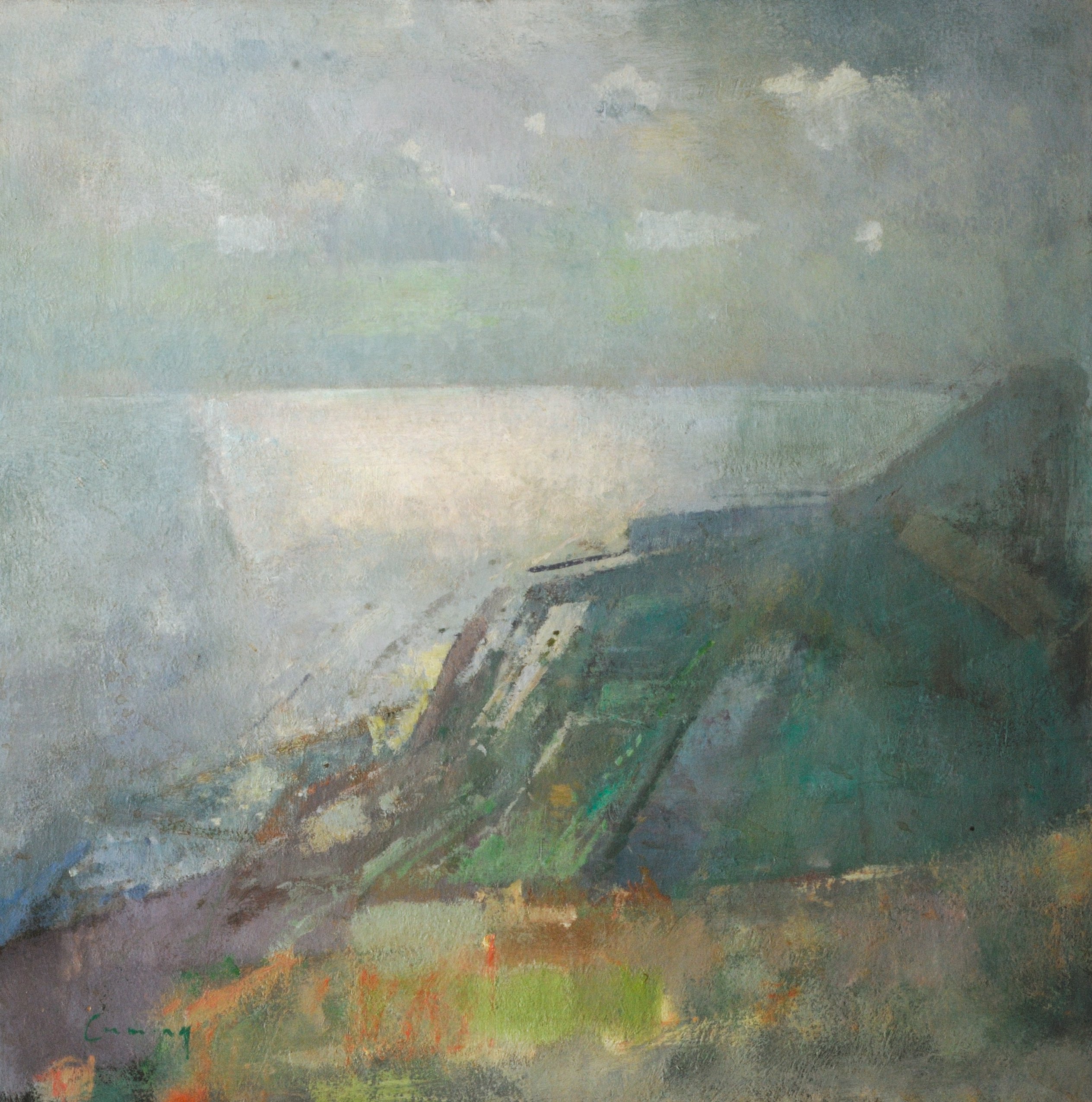21. Fairlight Cove, by Fred Cuming
 Fred Cuming, Fairlight Cove, oil on board, acquired 1988, H 60.3 x W 60.3 cm
Fred Cuming, Fairlight Cove, oil on board, acquired 1988, H 60.3 x W 60.3 cm
Fred
Cuming’s work revolves around the illumination of an
intensified, poetic version of the world. Elected as a Royal Academician in
1974, his work is often said to follow in the British tradition of atmospheric
landscape painting inaugurated by J.M.W. Turner in the nineteenth century, and
he has said that he is inspired by colourists such as Pierre Bonnard, Henri
Matisse, and Paul Nash. Cuming’s
canvases are built up of layers of painting, the underpainting often informing
the luminosity of the surface as the warmer base layers irradiate the later
applications. In this, he is certainly more akin to Turner’s atmospheric
effects and emphasis on light rather than the often intense and yet more open
brush-work of Bonnard or Matisse.
Cuming’s painting is also
intimately tied to the British landscape, especially the south coast of
England, and in certain periods his work could even be described as parochial –
dwelling upon the sea side in a manner that blends activity with a timelessness
verging on nostalgia. However, this painting, Fairlight Cove (acquired for the College in 1988 by Professor Peter
Hacker), arguably belongs to the more interesting group of Cuming’s work that
deals with landscape on the verge of abstraction. Instead of small, suggestive
brushstrokes that indicate figures or details in an invocation of objects that
recalls the Impressionism’s concern with the immediate moment, this painting is
made up of blocks of paint, applied with a brush and palette knife in a way
that renders the landscape monumental and immaterial at the same time.
‘I am not interested in
pure representation’, Cuming has said. ‘My work is about responses to the moods and atmospheres generated by landscape,
still life or interior. I am interested in the developments of 20th-century
painting in abstraction...and in new ideas and art forms.’
In Fairlight Cove, the viewer is kept suspended from the
landscape, neither placed within it nor comfortably excluded. We are almost
blinded by the shining oblong that is light reflected on the sea, an effect
sharpened by the geometric architectonics of the rocks. The basic forms of the
landscapes are given to us, but not as a solid material form. Instead the
landscape shimmers between solidity and luminosity. Cuming’s work intends to
take us beyond the materiality of the world around us and into affect – we can
hear this in his writings, where he speaks of the transformative powers of
light:
‘From my studio shed I see everything transformed by the angle of
the light in autumn evenings, a magical half-hour of brilliant gold light
against shadows and darker areas. The jam-jar on my window-sill holding dead
flowers, thistles and teasels is transmuted into gold, a treasure from the tomb
of Tutankhamun.’
These transmutations recall the eighteenth-century interest in
Britain in notions of beauty as a transportive sensory experience that can take
the viewer beyond the mere everyday towards a higher even a transcendent form
of sight. In particular, Cuming’s luminescent forms and their break with pure
representation evoke Joseph Addison’s writings on the imagination from 1712,
and his belief that sight furnishes the imagination with its ideas:
'[Sight] fills the mind with largest variety of ideas, converses
with its objects at the greatest distance […] [Sight] may be considered as a
more delicate and diffusive kind of touch, that spreads itself over an infinite
multitude of bodies, comprehends the largest figures, and brings into our reach
some of the most remote parts of the universe.'
(Joseph Addison,
‘Pleasures of the Imagination’, Spectator, No. 411, June 21, 1712.)
At the end of term, perhaps we could all do with a few minutes to lose ourselves in Cuming’s glittering landscape, and to let our imaginations
roam amongst the distant sea and clouds.
View the painting on Art UK here.
 Dr Jennifer Johnson, Junior Research Fellow in History of Art
Dr Jennifer Johnson, Junior Research Fellow in History of Art